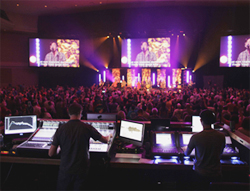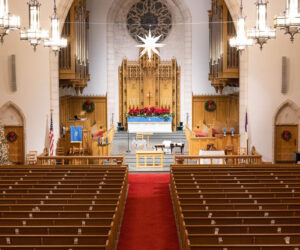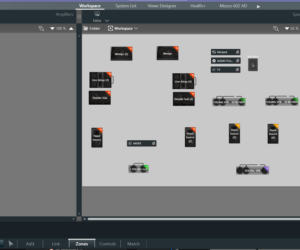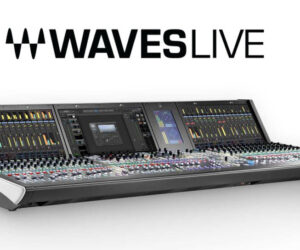James River Assembly (JRA) is among the first venues in the United States to take delivery and install a new DiGiCo SD5 consoles.
Taking advantage of a limited-time “Trade Up” offer from U.S. distributor Group One Limited–and working through Special Event Services (SES)–the 12,000-member house of worship in Springfield, MO, traded up their outdated large-format digital console with credit toward the purchase of two SD5s, plus an SD10 to accommodate its growing congregation.
The consoles were also a perfect fit for their staff, offering stellar flexibility, expandable I/Os for future growth, and a streamlined audio footprint for their South Campus as well as their West Campus, which opens in December.
JRA audio director Stephen Maddox selected the SD5 for the main campus FOH after seeing its debut at the 2012 InfoComm show, adding an SD10 for monitors. An additional SD5 was purchased for FOH at the West Campus with technical engineer Brian Roggow overseeing the installation there.
JRA pulled the old consoles—which freed up loads of space—after a Sunday morning service and had the DiGiCo units up and operational for rehearsals the following Tuesday.
“With the audio system revamp, we waited because we knew it would be a larger undertaking,” explains Maddox, “and one that would entail putting in an entirely new speaker system but also modifying the architecture of the room, and updating the microphones, soundboard, etc. We moved forward with the vision of our lead pastor John Lindell in mind. It was a team effort from the whole staff here. When the previous system was designed, the church was doing a classic contemporary musical style, which included a choir and orchestra.
“Since that time the church has transitioned musically to a rock/contemporary style of worship, but the old sound system wasn’t able to keep up with the output,” he continues. “The speakers were the main culprit and got the conversation started for the revamp. Once we decided on the PA—an Outline GTO with Powersoft K8 amplifiers and XTA DSP—we moved on to looking for consoles.”
Having consistency with the consoles at both the South Campus and the West Campus—running at 96 kHz—helped JRA achieve a streamlined sonic clarity as well. “It’s not like each venue is different,” Maddox says. “It’s the James River sound. Our tagline is, ‘one church, two locations.’ We want the experience at either campus to be the same. The PM1D was a nice board at the time we bought it but it lacked the warmth and depth that the DiGiCo has. When we first turned it on, I could hear the difference. It’s a very clear console, very warm, and the clarity alone is a nice feature in itself.”
The console’s flexibility was another bonus for both engineers. “I think the DiGiCos are very easy to understand and get around on,” Roggow offers. “You can see a lot of information at a quick glance. I like the fact that they can easily be a multi-user, multitasking console. I like that much better than a single-channel control approach, too.”
“With a lot of the other manufacturers’ consoles, you’re limited by its design in how you have to use it,” Maddox adds. “Since I started programming on the DiGiCo, it’s been very much of a, ‘this is what we’re giving you, how do you want to use it?’ experience. That was extremely beneficial to me because no longer was it how do I have to do it but rather how do I want to do it. Part of that intuitiveness is being able to lay out the console like you want to, with either a musical or logical layout, for a specific part in our service; it’s very straightforward and easy to program. Some of the specific features I like are the floating inputs, allowing you to put anything where you want it. The virtual sound check is a huge performance boost allowing you to mix without people on stage.
“Also, the Set Spill option is great. Even though I have each piece of the band individually laid out in layers and banks how I want, it’s very nice to be able to spill them out and it allows me to have the whole band show up on both banks with quick access to them. The macros are a huge plus, too, giving you the flexibility to program them for any scenario you can imagine because you can virtually program anything on the desk to a Macro.”
The Waves SoundGrid Bundle also adds to the overall palette. “Having them as an option is great,” explains Maddox, “but everything onboard is pretty phenomenal and the console itself is good enough on its own—from the DigiTubes, which give you the nice dynamic, tube-quality EQ, to the onboard dynamic EQ, to the multiband compressor or built-in De-esser they all sound nice. I would be fine if I didn’t have the Waves plug-ins, but they give you more to paint with and they’re a nice option to have. The PuigChild, modeled after the Fairchild, is a favorite, or the CLA compressors. The C6 is a great multiband compressor and it’s very easy to use. The Renaissance De-Esser is good, as is the SSL Compression or the SSL Channel Strip with its compressor and EQ options.”
Along with their new in-ear monitor systems, comprised of a wired Shure PSM 600 for the six-to-seven-piece band, wireless Shure PSM 900 for the three to four main leaders and soloists, and Sennheiser EW500 G3s, (each with a stereo mix), for the five to six background singers, the SD10 at monitor world has been another seamless experience for JRA.
“I don’t think I’ve ever had such an easy experience on a monitor console,” offers Maddox. “It’s all right there and a very nice, simple process. Our in-ears are so much clearer and sound so nice. It’s been a seamless upgrade and a great experience for everyone.”
The console’s main monitor engineer, Tucker Fredock, has found a lot to love onboard the console. “The layer feature makes it simpler to move around the board,” he says “Also, since we have so many different musicians that play each week, I can save their mixes as mix presets. It’s great to have a touchscreen on the SD10. The DiGiCo Gain Tracking is very accurate since in our setup FOH has gain control and it seamlessly follows when FOH makes adjustments. I love the multiband compressors and use them on the output mixes.
“Also, because we’re running the console in 96 kHz, it brings out more of the clarity in each instrument. The drums sound fuller and the voices stick out more in the mixes, kind of like a 3D image. Overall, I think the SD10 is a better product than what we were using before.”




















